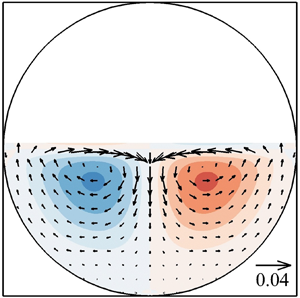Article contents
Effect of secondary currents on the flow and turbulence in partially filled pipes
Published online by Cambridge University Press: 15 March 2022
Abstract

Large-eddy simulations of turbulent flow in partially filled pipes are conducted to investigate the effect of secondary currents on the friction factor, first- and second-order statistics and large-scale turbulent motion. The method is validated first and simulated profiles of the mean streamwise velocity, normal stresses and turbulent kinetic energy (TKE) are shown to be in good agreement with experimental data. The secondary flow is stronger in half- and three-quarters full pipes compared with quarter full or fully filled pipe flows, respectively. The origin of the secondary flow is examined by both the TKE budget and the steamwise vorticity equation, providing evidence that secondary currents originate from the corner between the free surface and the pipe walls, which is where turbulence production is larger than the sum of the remaining terms of the TKE budget. An extra source of streamwise vorticity production is found at the free surface near the centreline bisector, due to the two-component asymmetric turbulence there. The occurrence of dispersive stresses (due to secondary currents) reduces the contribution of the turbulent shear stress to the friction factor, which results in a reduction of the total friction factor of flows in half and three-quarters full pipes in comparison to a fully filled pipe flow. Furthermore, the presence of significant secondary currents inhibits very-large-scale motion (VLSM), which in turn reduces the strength and scales of near-wall streaks. Subsequently, near-wall coherent structures generated by streak instability and transient growth are significantly suppressed. The absence of VLSM and less coherent near-wall turbulence structures is supposedly responsible for the drag reduction in partially filled pipe flows relative to a fully filled pipe flow at an equivalent Reynolds number.
JFM classification
- Type
- JFM Papers
- Information
- Copyright
- © The Author(s), 2022. Published by Cambridge University Press
References
REFERENCES
- 15
- Cited by





